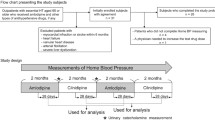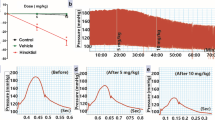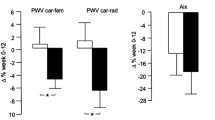Summary
Eight patients with a diastolic blood pressure ⩾ 100mm Hg when treated with a diuretic and a β-blocker participated in a randomised crossover study comparing the haemodynamic effects of adjunctive therapy with pinacidil or hydralazine. The vasodilator dose was increased until the diastolic blood pressure was < 90mm Hg or the maximum dosage, hydralazine 100mg twice daily, or pinacidil 50mg twice daily, was reached. Treatment continued for 3 to 6 months and a haemodynamic study was performed. After washout, the patients received the alternative treatment.
In the upright position, during supine rest and during isometric as well as dynamic exercise, pinacidil lowered blood pressure more effectively than hydralazine. No differences between the 2 treatments were found in heart rate, stroke index, cardiac index, end systolic wall stress or glomerular filtration rate. Pulmonary mean and wedge pressure were lower during treatment with pinacidil. Forearm blood flow was higher and forearm vascular resistance lower during treatment with pinacidil. Cardiac contractility, judged from the systolic time interval ratio PEP: LVET, was lower during treatment with pinacidil compared with hydralazine. The median daily dose of pinacidil was 50mg and that of hydralazine 200mg.
It was also noted that during long term treatment, pinacidil seemed more effective in reducing blood pressure than hydralazine.
Similar content being viewed by others
References
Aablad B. A study of the mechanism of the haemodynamic effects of hydralazine in man. Acta Pharmacologica et Toxicologica 20: 1–53, 1963
Angelo HR, Christensen JM, Kristensen M, McNair A. Gas Chromatographic method for the simultaneous determination of hydralazine and its acetylated metabolite in serum using a nitrogen-selective detector. Journal of Chromatography 183: 159–166, 1980
Arrigoni-Martelli E, Kaergaard Nielsen C, Bang Olsen U, Petersen JH. N″-cyano-N-4-pyridyl-N″-l,2,2-trimethyl-propylguanidine, monohydrate (P 1134): a new, potent vasodilator. Experientia 36: 445–447, 1980
Bray KM, Newgreen DT, Small RC, Southerton JS, Taylor SG, et al. Evidence that the mechanism of the inhibitory action of pinacidil in rat and guinea-pig smooth muscle differs from that of glyceryl trinitrate. British Journal of Pharmacology 91: 421–429, 1987
Carlsen JE, Kardel T, Hilden T, Tangø M, Trap-Jensen J. Immediate central and peripheral haemodynamic effects of a new vasodilating agent pinacidil (P 1134) in hypertensive man. Clinical Physiology 1: 375–384, 1981
Carlsen JE, Kardel T, Jensen HE, Tangø M, Trap-Jensen J. Pinacidil, a new vasodilator: pharmacokinetics and pharmacodynamics of a new retarded release tablet in essential hypertension. European Journal of Clinical Pharmacology 25: 557–561, 1983
Carlsen JE, Kardel T, Lund JO, McNair A, Trap-Jensen J. Acute hemodynamic effects of pinacidil and hydralazine in essential hypertension. Clinical Pharmacology and Therapeutics 37: 253–259, 1985
Cook NS, Quast V, Hof RP, Baumlin Y, Pally C. Similarities in the mechanism of action of two new vasodilator drugs: pinacidil and BRL 34915. Journal of Cardiovascular Pharmacology 11: 90–99,1988
Dahn I, Hallböök T. Simultaneous blood flow measurements by water and strain gauge plethysmography. Scandinavian Journal of Clinical Laboratory Investigations 25: 419–429, 1970
Forrester JS, Ganz W, Diamond G, McHugh T, Chonette DW, Swan HJC. Thermodilution cardiac output determination with a single flow-directed catheter. American Heart Journal 83: 306–311, 1972
Freis ED, Rose JC, Higgins TF, Finnerty FA, Kelley RT, Partenope EA. The hemodynamic effects of hypotensive drugs in man. Circulation 8: 199–204, 1953
Henningsen NC, Hanson A, Wernersson B. Single versus multiple daily administration of hydralazine in the maintenance treatment of hypertension. Acta Medica Scandinavica 211: 179–185, 1982
Hermsmeyer RK. Ion channel effects of pinacidil in vascular muscle. Drugs 36(Suppl. 7): 29–32, 1988
Kardel T, Hilden T, Carlsen JE, Trap-Jensen J. N″-cyano-N-4-pyridyl-N″-l,2,2-trimethyl-propylguanidine, a new vasodilating agent: acute effect on blood pressure and pharmacokinetics in hypertensive patients. Journal of Cardiovascular Pharmacology 3: 1002–1007, 1981
Koch Weser J. Hydralazine. New England Journal of Medicine 295: 320–323, 1976
Rehling M, Møller ML, Lund JO, Jensen KB, Thamdrup B, Trap-Jensen J. 99mTc-DTPA gamma-camera renography: normal values and rapid determination of single-kidney glomerular filtration rate. European Journal of Nuclear Medicine 11: 1–6, 1985
Reichek N, Wilson J, Sutton MSJ, Plappert TA, Glodberg S, Hirshfeld JW. Non invasive determination of left ventricular end-systolic stress: validation of the method and initial application. Circulation 65: 99–108, 1982
Tarazi RC, Dustan HP, Bravo EL, Niarchos AP. Vasodilating drugs: contrasting haemodynamic effects. Clinical Science and Molecular Medicine 51: 575s–578s, 1976
Videbaek LM, Aalkjaer C, Mulvany MJ. Vasodilatation with pinacidil: mode of action in rat resistance vessels. Drugs 36(Suppl.7): 33–40, 1988
Weissler AM, Lewis RP, Leighton RF. The systolic time intervals as a measure of left ventricular performance in man. In Yu PN, Goodwin JF (Eds) Progress in cardiology, vol. 1, Lea & Febiger, Philadelphia, 1972
Weston AH, Bray KM, Duty S, McHarg AD, Newgreen DT, Southerton JS. In vitro studies on the mode of action of pinacidil. Drugs 36(Suppl. 7): 10–28, 1988
Author information
Authors and Affiliations
Rights and permissions
About this article
Cite this article
Carlsen, J.E., Jensen, H.A., Rehling, M. et al. Long Term Haemodynamic Effects of Pinacidil and Hydralazine in Arterial Hypertension. Drugs 36 (Suppl 7), 55–63 (1988). https://doi.org/10.2165/00003495-198800367-00010
Published:
Issue Date:
DOI: https://doi.org/10.2165/00003495-198800367-00010




